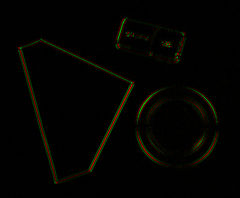Difference between revisions of "Example Image Derivative"
From BoofCV
Jump to navigationJump to searchm |
m |
||
| Line 10: | Line 10: | ||
Example Code: | Example Code: | ||
* [https://github.com/lessthanoptimal/BoofCV/blob/v0. | * [https://github.com/lessthanoptimal/BoofCV/blob/v0.37/examples/src/main/java/boofcv/examples/imageprocessing/ExampleImageDerivative.java ExampleImageDerivative.java] | ||
Concepts: | Concepts: | ||
| Line 26: | Line 26: | ||
*/ | */ | ||
public class ExampleImageDerivative { | public class ExampleImageDerivative { | ||
public static void main(String[] args) { | public static void main( String[] args ) { | ||
BufferedImage input = UtilImageIO.loadImage(UtilIO.pathExample("simple_objects.jpg")); | BufferedImage input = UtilImageIO.loadImage(UtilIO.pathExample("simple_objects.jpg")); | ||
// We will use floating point images here, but GrayU8 with GrayS16 for derivatives also works | // We will use floating point images here, but GrayU8 with GrayS16 for derivatives also works | ||
GrayF32 grey = new GrayF32(input.getWidth(),input.getHeight()); | GrayF32 grey = new GrayF32(input.getWidth(), input.getHeight()); | ||
ConvertBufferedImage.convertFrom(input, grey); | ConvertBufferedImage.convertFrom(input, grey); | ||
// First order derivative, also known as the gradient | // First order derivative, also known as the gradient | ||
GrayF32 derivX = new GrayF32(grey.width,grey.height); | GrayF32 derivX = new GrayF32(grey.width, grey.height); | ||
GrayF32 derivY = new GrayF32(grey.width,grey.height); | GrayF32 derivY = new GrayF32(grey.width, grey.height); | ||
GImageDerivativeOps.gradient(DerivativeType.SOBEL, grey, derivX, derivY, BorderType.EXTENDED); | GImageDerivativeOps.gradient(DerivativeType.SOBEL, grey, derivX, derivY, BorderType.EXTENDED); | ||
// Second order derivative, also known as the Hessian | // Second order derivative, also known as the Hessian | ||
GrayF32 derivXX = new GrayF32(grey.width,grey.height); | GrayF32 derivXX = new GrayF32(grey.width, grey.height); | ||
GrayF32 derivXY = new GrayF32(grey.width,grey.height); | GrayF32 derivXY = new GrayF32(grey.width, grey.height); | ||
GrayF32 derivYY = new GrayF32(grey.width,grey.height); | GrayF32 derivYY = new GrayF32(grey.width, grey.height); | ||
GImageDerivativeOps.hessian(DerivativeType.SOBEL, derivX, derivY, derivXX, derivXY, derivYY, BorderType.EXTENDED); | GImageDerivativeOps.hessian(DerivativeType.SOBEL, derivX, derivY, derivXX, derivXY, derivYY, BorderType.EXTENDED); | ||
// There's also a built in function for computing arbitrary derivatives | // There's also a built in function for computing arbitrary derivatives | ||
AnyImageDerivative<GrayF32,GrayF32> derivative = | AnyImageDerivative<GrayF32, GrayF32> derivative = | ||
GImageDerivativeOps.createAnyDerivatives(DerivativeType.SOBEL, GrayF32.class, GrayF32.class); | GImageDerivativeOps.createAnyDerivatives(DerivativeType.SOBEL, GrayF32.class, GrayF32.class); | ||
| Line 56: | Line 56: | ||
// Visualize the results | // Visualize the results | ||
ListDisplayPanel gui = new ListDisplayPanel(); | ListDisplayPanel gui = new ListDisplayPanel(); | ||
gui.addImage(ConvertBufferedImage.convertTo(grey,null),"Input Grey"); | gui.addImage(ConvertBufferedImage.convertTo(grey, null), "Input Grey"); | ||
gui.addImage(VisualizeImageData.colorizeSign(derivX, null, -1),"Sobel X"); | gui.addImage(VisualizeImageData.colorizeSign(derivX, null, -1), "Sobel X"); | ||
gui.addImage(VisualizeImageData.colorizeSign(derivY, null, -1),"Sobel Y"); | gui.addImage(VisualizeImageData.colorizeSign(derivY, null, -1), "Sobel Y"); | ||
// Use colors to show X and Y derivatives in one image. Looks pretty. | // Use colors to show X and Y derivatives in one image. Looks pretty. | ||
gui.addImage(VisualizeImageData.colorizeGradient(derivX, derivY, -1, null),"Sobel X and Y"); | gui.addImage(VisualizeImageData.colorizeGradient(derivX, derivY, -1, null), "Sobel X and Y"); | ||
gui.addImage(VisualizeImageData.colorizeSign(derivXX, null,-1),"Sobel XX"); | gui.addImage(VisualizeImageData.colorizeSign(derivXX, null, -1), "Sobel XX"); | ||
gui.addImage(VisualizeImageData.colorizeSign(derivXY, null,-1),"Sobel XY"); | gui.addImage(VisualizeImageData.colorizeSign(derivXY, null, -1), "Sobel XY"); | ||
gui.addImage(VisualizeImageData.colorizeSign(derivYY, null,-1),"Sobel YY"); | gui.addImage(VisualizeImageData.colorizeSign(derivYY, null, -1), "Sobel YY"); | ||
gui.addImage(VisualizeImageData.colorizeSign(derivXYX, null,-1),"Sobel XYX"); | gui.addImage(VisualizeImageData.colorizeSign(derivXYX, null, -1), "Sobel XYX"); | ||
ShowImages.showWindow(gui,"Image Derivatives",true); | ShowImages.showWindow(gui, "Image Derivatives", true); | ||
} | } | ||
} | } | ||
</syntaxhighlight> | </syntaxhighlight> | ||
Revision as of 18:18, 21 December 2020
Example of how to compute different image derivatives. The gradient (1st order derivative) is probably the important image derivative and is used as a first step when extracting many types of image features. The code below shows how gradient, Hessian (2nd order), and arbitrary image derivatives can be computed.
Example Code:
Concepts:
- Image Derivative
- Gradient
- Hessian
Example Code
/**
* Example showing how to compute different image derivatives using built in functions.
*
* @author Peter Abeles
*/
public class ExampleImageDerivative {
public static void main( String[] args ) {
BufferedImage input = UtilImageIO.loadImage(UtilIO.pathExample("simple_objects.jpg"));
// We will use floating point images here, but GrayU8 with GrayS16 for derivatives also works
GrayF32 grey = new GrayF32(input.getWidth(), input.getHeight());
ConvertBufferedImage.convertFrom(input, grey);
// First order derivative, also known as the gradient
GrayF32 derivX = new GrayF32(grey.width, grey.height);
GrayF32 derivY = new GrayF32(grey.width, grey.height);
GImageDerivativeOps.gradient(DerivativeType.SOBEL, grey, derivX, derivY, BorderType.EXTENDED);
// Second order derivative, also known as the Hessian
GrayF32 derivXX = new GrayF32(grey.width, grey.height);
GrayF32 derivXY = new GrayF32(grey.width, grey.height);
GrayF32 derivYY = new GrayF32(grey.width, grey.height);
GImageDerivativeOps.hessian(DerivativeType.SOBEL, derivX, derivY, derivXX, derivXY, derivYY, BorderType.EXTENDED);
// There's also a built in function for computing arbitrary derivatives
AnyImageDerivative<GrayF32, GrayF32> derivative =
GImageDerivativeOps.createAnyDerivatives(DerivativeType.SOBEL, GrayF32.class, GrayF32.class);
// the boolean sequence indicates if its an X or Y derivative
derivative.setInput(grey);
GrayF32 derivXYX = derivative.getDerivative(true, false, true);
// Visualize the results
ListDisplayPanel gui = new ListDisplayPanel();
gui.addImage(ConvertBufferedImage.convertTo(grey, null), "Input Grey");
gui.addImage(VisualizeImageData.colorizeSign(derivX, null, -1), "Sobel X");
gui.addImage(VisualizeImageData.colorizeSign(derivY, null, -1), "Sobel Y");
// Use colors to show X and Y derivatives in one image. Looks pretty.
gui.addImage(VisualizeImageData.colorizeGradient(derivX, derivY, -1, null), "Sobel X and Y");
gui.addImage(VisualizeImageData.colorizeSign(derivXX, null, -1), "Sobel XX");
gui.addImage(VisualizeImageData.colorizeSign(derivXY, null, -1), "Sobel XY");
gui.addImage(VisualizeImageData.colorizeSign(derivYY, null, -1), "Sobel YY");
gui.addImage(VisualizeImageData.colorizeSign(derivXYX, null, -1), "Sobel XYX");
ShowImages.showWindow(gui, "Image Derivatives", true);
}
}


